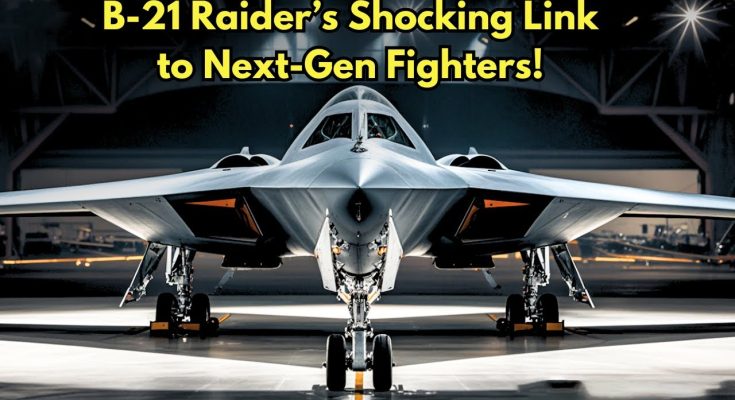In 2025, the unveiling of the B-21 Raider by the United States Air Force (USAF) has captivated the world with its sleek design, advanced stealth technology, and revolutionary capabilities. However, what has stunned defense analysts and military experts alike is its unexpected yet pivotal role in the U.S. 6th Generation Fighter Jet Program. Traditionally, the B-21 Raider, as a strategic bomber, is designed for long-range, high-altitude missions, delivering both conventional and nuclear payloads. Yet, its role in the 6th generation fighter program introduces a new chapter in military aviation, blending the capabilities of bombers and fighters in a way never seen before.
The B-21 Raider: A Next-Gen Stealth Bomber
The B-21 Raider is the latest addition to the U.S. bomber fleet, designed to replace the aging B-1B Lancer and B-2 Spirit bombers. What makes the B-21 so remarkable is its ability to operate in highly contested airspaces with its stealth features, advanced electronic warfare systems, and ability to carry hypersonic weapons. The aircraft is built with cutting-edge radar-absorbing materials and features a highly low-observable design that allows it to penetrate enemy defenses undetected. These qualities, along with its precision strike capabilities, make the B-21 an essential asset for strategic deterrence and global power projection.
A Fusion of Roles: Fighter and Bomber
What’s surprising, however, is how the B-21 Raider is being integrated into the future of the 6th generation fighter jet program. Traditionally, bombers like the B-21 and fighters operate in different realms—bombers are designed to strike high-value targets at long distances, while fighters engage in air superiority and close support. But in the age of networked warfare, these distinctions are beginning to blur.
The B-21 Raider is equipped with advanced AI-driven systems, sensor fusion technology, and autonomous capabilities, positioning it to collaborate seamlessly with future 6th generation fighters. Rather than simply fulfilling a traditional bomber role, the B-21 will be an integral part of a multi-domain operations network, coordinating with fighter jets, drones, and satellites to conduct operations in a dynamic and complex battlespace.
Collaborative Combat Strategy
The B-21’s unexpected involvement in the 6th generation fighter program lies in its ability to extend the reach and enhance the survivability of fighters. The B-21 could provide a “loitering platform” from which 6th generation fighters can receive real-time updates, relay intelligence, and launch precision strikes without exposing themselves to enemy radar or missile systems. In essence, the B-21 can act as a combat coordinator, directing fighters to optimal attack positions while staying safely out of harm’s way.
Moreover, the sensor fusion technology embedded in the B-21 allows it to function as a “force multiplier,” feeding information into the broader combat network, linking fighters, bombers, and ground forces in ways that provide tactical superiority. The B-21’s role would go beyond merely delivering bombs—its sensors could scan the battlefield, identify targets, and guide fighters in real-time to engage those targets more effectively.
The B-21 as a Platform for Hypersonic Integration
Another key role for the B-21 in the 6th generation fighter program involves the integration of hypersonic weapons. As the U.S. continues to develop cutting-edge hypersonic missiles capable of traveling at speeds greater than Mach 5, the B-21 will play a pivotal role in carrying and deploying these game-changing weapons. In this capacity, the B-21 would complement future fighters, which may not be designed to carry such payloads, by providing a launch platform from which hypersonic strikes can be carried out against high-value targets deep within enemy territory.
Furthermore, the integration of hypersonic capabilities into the B-21’s operational framework means that it could collaborate with 6th generation fighters, potentially releasing hypersonic weapons at extended ranges, while fighters maintain air superiority or complete ground support missions. The synergy between the bomber and fighter platforms would give the U.S. Air Force a much greater multi-layered strike capability.
Strategic Deterrence and Global Power Projection
The B-21’s involvement in the 6th generation fighter program is also a reflection of the evolving nature of global deterrence and power projection. As adversaries like China and Russia develop increasingly sophisticated air defense systems, the U.S. military must find innovative ways to maintain its edge. By integrating long-range bombers like the B-21 into the fighter program, the Air Force enhances its ability to strike from afar while still ensuring that air superiority is maintained by next-gen fighters.
This multi-domain strategy ensures that the U.S. maintains both strategic reach and tactical flexibility in global conflicts, making it harder for adversaries to predict where or when U.S. forces will strike. It also ensures that fighters are not just operating in isolation but are part of a broader, interconnected network of assets capable of executing highly complex, coordinated missions.
Conclusion: A Game-Changing Approach
The B-21 Raider’s role in the 6th generation fighter jet program represents a significant shift in how the U.S. views the integration of bomber and fighter capabilities. While bombers have traditionally been seen as separate from the fighter realm, the B-21 is set to blur those lines by serving as both a strike platform and a critical piece in a broader combat network. Its stealth, AI integration, sensor fusion, and hypersonic capabilities make it an ideal complement to next-generation fighter jets, enhancing their capabilities and ensuring the U.S. maintains technological superiority on the battlefield. The collaboration between bombers and fighters in the future of warfare represents an evolution of the multi-domain battle space, and the B-21 Raider’s unexpected role in this program highlights how military innovation continues to outpace traditional thinking.



